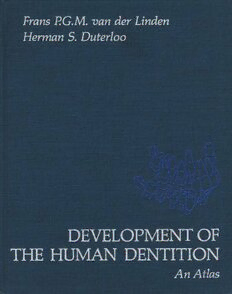
Development of the Human Dentition: An Atlas PDF
Preview Development of the Human Dentition: An Atlas
First published as Gebitsontwikkeling bij de mens, in Dutch in 2010 by Bohn Stafleu van Loghum in Houten, The Netherlands. © 2013 Quintessence Publishing Co, Inc Quintessence Publishing Co Inc 4350 Chandler Drive Hanover Park, IL 60133 www.quintpub.com All rights reserved. This book or any part thereof may not be reproduced, stored in a retrieval system, or transmitted in any form or by any means, electronic, mechanical, photocopying, or otherwise, without prior written permission of the publisher. Editor: Bryn Grisham Design/Production: Angelina Sanchez eBook ISBN 978-0-86715-524-2 Table of Contents List of Video Clips About the Author Preface Acknowledgments Author’s Note on Terminology 1 Formation of Teeth 2 Jaw Growth During Formation and Eruption of Deciduous Teeth 3 The First Transitional Period: Transition of Incisors and Emergence of First Permanent Molars 4 Intertransitional Period 5 The Second Transitional Period: Transition of Canines and Deciduous Molars/Premolars and Emergence of Second Permanent Molars 6 Changes in the Molar Region 7 The Adult Dentition 8 General Aspects of the Development of the Dentition 9 Growth and Development of the Facial Complex: Interactions Among the Dentition, Skeleton, and Function 10 Abnormalities of the Dental Arches 11 Class II, Division 1 Malocclusions 12 Class II, Division 2 Malocclusions 13 Class III Malocclusions 14 Open Bites and Nonocclusions 15 Asymmetries, Transverse Deviations, and Forced Bites 16 Premature Loss of Deciduous Teeth 17 Statistical Data List of Video Clips Clip Title Duration (min:sec) 1 Tooth Development 3:53 2 Formation of Mandibular Molar Crown 0:58 3 Formation of Mandibular Incisor 0:19 4 Formation of Mandibular Canine 0:19 5 Formation of Mandibular Molar 0:24 6 Formation of Mandibular Incisor, Canine and Molar 0:22 7 Eruption and Transition of Central Incisors with Surrounding Soft Tissues 0:20 8 Transition of Mandibular Incisors with Moderate Space 0:19 9 Transition of Maxillary Incisors with Moderate Space 0:12 10 Transition of Mandibular and Maxillary Incisors with Moderate Space 0:20 11 Transition of Mandibular Incisors with Excess of Space 0:21 12 Transition of Maxillary Incisors with Excess of Space 0:18 13 Transition of Mandibular Incisors with Shortage of Space 0:20 14 Transition of Maxillary Incisors with Shortage of Space 0:21 15 Changes of Maxillary Permanent Incisors After Extraction of Deciduous Canines in Anterior Crowding 0:30 16 Transition of Canines and Premolars with Excess of Space 0:15 17 Transition of Canines and Premolars with Moderate Space 0:16 18 Transition of Canines and Premolars with Shortage of Space 0:17 19 Eruption of Second Permanent Molars 0:15 20 Eruption of Third Permanent Molars 0:18 21 Movements of First Permanent Molars 0:20 22 Rail Mechanism 0:17 23 Resorption of Deciduous Molar Associated with Eruption of Premolar 0:14 24 Eruption Rate and Reduction of Eruption by Force Application 1:43 25 Rotating Overview of Developing Dentition 1:39 26 Cone-Funnel Mechanism 0:49 27 Normal Tooth Mobility 0:19 28 Excessive Tooth Mobility Caused by Periodontal Breakdown 0:17 29 Radiographic Movie of Swallowing 0:13 30 Eruption and Transition of Central Incisors in Severe Class II/1 with Anterior Soft Tissues and Lip-interposition 0:21 31 Lateral View of Development of Severe Class II/1 Malocclusion 0:51 32 Various Stages Between Normal Occlusion and Severe Class II/1 Malocclusion 0:15 33 Tipping of Central Incisors with Anterior Soft Tissues 0:15 34 Over-eruption and Tipping of Central Incisors in Class II/2 0:15 35 Frontal View of Development of Class II/2 Type A 0:19 36 Lateral View of Development of Class II/2 Type B 0:48 37 Frontal View of Development of Class II/2 Type B 0:19 38 Lateral View of Tipping of Incisors in Class II/2 Type B 0:17 39 Lateral View of Development of Class I Malocclusion with Symptoms of Class II/2 Type A 0:57 40 Lateral View of Development of Class II/2 Type C 0:52 41 Eruption and Transition of Central Incisors in Class III with Anterior Soft Tissues 0:20 42 Lateral View of Development of Severe Class III Malocclusion 0:34 43 Lateral View of Development of Mild Class III Malocclusion 0:34 44 Various Stages Between Mild and Severe Class III Malocclusions 0:21 45 Over-eruption and Tipping of Central Incisors in Class III 0:14 46 Anterior Forced Bite in Mild Class III Malocclusion 0:17 47 Assessing Maximal Distal Movement in Anterior Forced Bite 0:22 48 Diagnosing Anterior Forced Bite Component in Mild Class III Malocclusion 0:14 49 Assessing Tongue Position at Rest 1:00 50 Space Creation by Erupting Mandibular Second Premolar 0:16 Information on the Source of the Video Clips Dr Frans P.G.M. van der Linden About the Author Dr Frans P.G.M. van der Linden received his dental and orthodontic education at the University of Groningen, the Netherlands. In addition he studied orthodontics at the University of Vienna, Austria, and the University of Washington, in Seattle, Washington. From 1962 until 1995 he held the position of Professor and Chairman of Orthodontics at the Radboud University Nijmegen, the Netherlands. In 1969-1970 he served as the Netherlands Visiting Professor at The University of Michigan, in Ann Arbor, Michigan. In 1975 he became the first European to be certified by the American Board of Orthodontics. Dr Van der Linden has a strong interest in education. He received a grant from the European Union to develop the curriculum with the chairpersons from 15 countries for a 3-year full-time postgraduate course in orthodontics; in 1992, this so-called Erasmus Programme became the international standard in the education of specialists in orthodontics. Dr Van der Linden is particularly interested in incorporating basic and clinical research results in the theory and practice of orthodontics. He is an internationally
